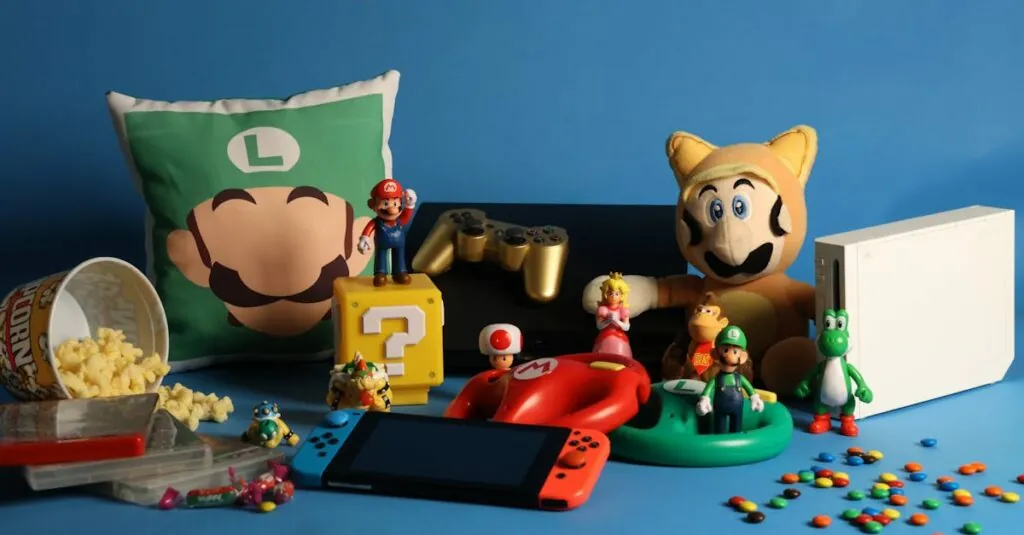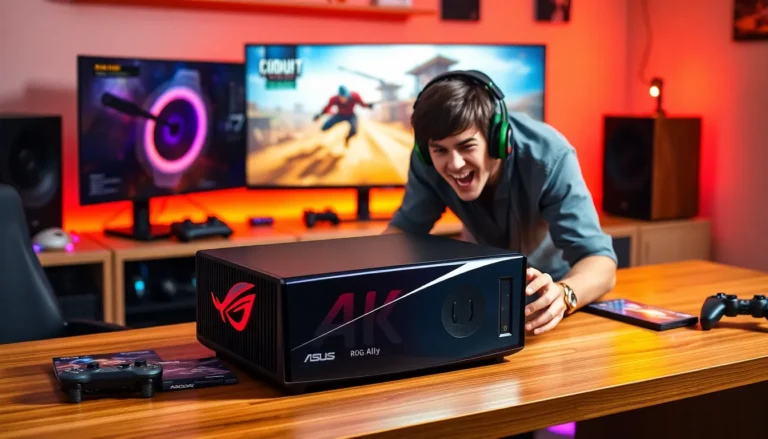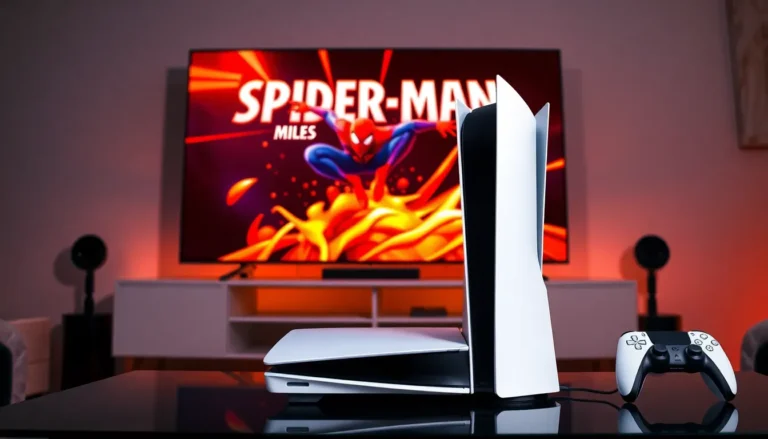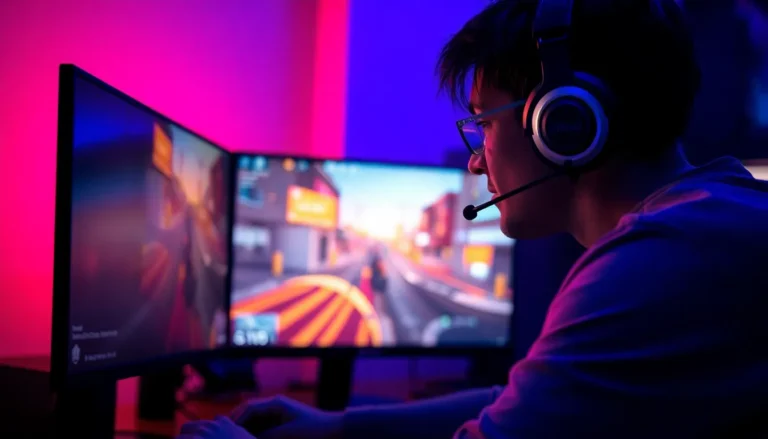In the epic showdown of gaming consoles, the Nintendo Switch and the Wii stand as titans of fun, each boasting its own unique charm. Picture this: one offers a sleek hybrid design that lets players game on the go, while the other revolutionized living rooms with motion controls that turned couch potatoes into dancing machines. It’s a battle of nostalgia versus innovation, and gamers everywhere are torn between reliving their childhood memories and embracing the future of play.
Table of Contents
ToggleOverview of Nintendo Switch and Wii
The Nintendo Switch launched in March 2017, offering a unique hybrid gaming experience. Players can transition seamlessly between handheld and docked modes, making it versatile for various play styles. The console features a diverse game library, including popular titles like “The Legend of Zelda: Breath of the Wild” and “Animal Crossing: New Horizons.”
In contrast, the Wii debuted in November 2006, marked by its revolutionary motion control system. Gamers wield the Wii Remote to interact with games, adding a physical element that changed gameplay dynamics. Iconic titles such as “Wii Sports” and “Super Mario Galaxy” capitalized on this feature, drawing in casual and experienced players alike.
A key difference lies in the user interface. The Switch employs a modern, touchscreen interface while the Wii’s interface revolves around a more traditional menu system. Both consoles support multiplayer gaming, but the Switch enhances this experience through online features and downloadable content.
Launch sales tell an interesting story. The Wii sold over 101 million units globally by the end of its production, while the Switch rapidly surpassed 125 million units within a few years. This trend underscores the growing preference for portable gaming.
In terms of backward compatibility, the Switch lacks support for Wii titles, yet it offers access to Nintendo’s extensive library through the Nintendo Switch Online service. Both systems highlight Nintendo’s ability to innovate, catering to different gaming preferences across generations. The nostalgia surrounding the Wii contrasts with the fresh excitement generated by the Switch, fueling ongoing discussions among gamers.
Design and Build Quality
The design and build quality of the Nintendo Switch and Wii showcase their unique approaches to gaming.
Nintendo Switch Features
The Nintendo Switch features a sleek, modern design with vibrant colors. Its hybrid nature allows transitions between handheld and docked play. Detachable Joy-Con controllers enhance versatility, catering to multiple play styles. The console’s tablet-like form ensures portability, making gaming accessible anywhere. A sturdy kickstand supports tabletop play, crucial for social gaming. Additionally, the screen boasts a 720p resolution in handheld mode and 1080p in docked mode, providing rich visuals during gameplay. The overall build quality feels robust, appealing to gamers who seek durability without sacrificing style.
Wii Features
The Wii emphasizes a compact and minimalist design, inviting casual gamers into the fold. Measuring only a few inches tall, its white casing blends seamlessly into home environments. Wireless motion-sensing controllers define its appeal, promoting physical engagement during gameplay. The console’s unique slot-loading disc drive eases the loading process, enhancing user experience. Notably lightweight, it allows for easy placement in various settings. The Wii’s simplistic interface provides clear navigation, making it accessible for players of all ages. Its build quality, characterized by sturdy components, ensures longevity despite its lightweight design.
Game Library Comparison
The Nintendo Switch and Wii boast distinct game libraries, each featuring exclusive titles that define their gaming experiences.
Exclusive Titles on Nintendo Switch
Popular titles dominate the Nintendo Switch ecosystem. “The Legend of Zelda: Breath of the Wild” revolutionized open-world gameplay, inviting players to explore Hyrule’s breathtaking landscapes. “Animal Crossing: New Horizons” captured the hearts of gamers with its charming life simulation and social interaction elements. Games like “Super Smash Bros. Ultimate” draw fans into epic battles with an extensive roster of iconic characters. “Splatoon 2” introduced vibrant, multiplayer chaos with its unique paint-splatting mechanics. In addition, “Fire Emblem: Three Houses” appeals to strategy enthusiasts with its immersive storylines and character development. The Switch’s expanding library continues to attract diverse gamers.
Exclusive Titles on Wii
Iconic titles characterized the Wii’s game library, emphasizing fun and accessibility. “Wii Sports” transformed family gaming by promoting physical activity through motion controls, becoming a staple for casual players. “Super Mario Galaxy” pushed platforming boundaries with innovative gravity mechanics and stunning visuals. Titles like “The Legend of Zelda: Skyward Sword” offered engaging narratives combined with motion-based gameplay, appealing to franchise fans. “Mario Kart Wii” provided thrilling multiplayer racing experiences, perfect for competitive gaming sessions. These exclusive games solidified the Wii’s reputation and created unforgettable memories for players of all ages.
Gameplay Experience
The gameplay experience on the Nintendo Switch and the Wii showcases distinct advantages that appeal to different gamers.
Multiplayer Capabilities
Multiplayer functionality stands out in both consoles. The Switch offers online play, allowing friends to connect from anywhere. Local multiplayer also remains accessible. Options like couch co-op enrich social experiences. Meanwhile, the Wii excels in local multiplayer through stylish motion-based games. Titles like “Wii Sports” and “Mario Kart Wii” create fun-filled gatherings. Each console provides a unique approach to multiplayer engagement, with the Switch leaning heavily on online features while the Wii champions local play.
Motion Controls
Motion controls represent a defining feature for the Wii. This innovation facilitates interactive gaming, immersing players in experiences like never before. Games utilizing the Wii Remote encourage physical activity, resulting in engaging family-friendly fun. The Switch, in contrast, includes motion control options primarily in select titles. While not as central to its identity, it offers versatility with its Joy-Con controllers. Gaming sessions on the Switch maintain excitement through a mix of traditional gameplay and motion-sensitive titles, blending the best of both worlds.
Performance and Graphics
Performance and graphics significantly vary between the Nintendo Switch and the Wii, impacting the gaming experience.
Switch Graphics Performance
The Nintendo Switch features robust graphics performance powered by its NVIDIA Tegra processor. This hardware allows games to run at 720p in handheld mode and 1080p while docked, providing vivid and engaging visuals. Notable titles like “The Legend of Zelda: Breath of the Wild” showcase detailed environments and smooth animations, enhancing immersion. Developers utilize the Switch’s capabilities to create stunning visuals across genres, allowing for diverse gaming experiences. Regular system updates further optimize graphical performance, ensuring titles run smoothly. The ability to play both at home and on the go adds another layer of versatility, appealing to gamers who value quality graphics in various settings.
Wii Graphics Performance
The Wii focuses on accessibility rather than cutting-edge graphics performance. Its GPU, though capable, supports a maximum resolution of 480p, which limits visual fidelity compared to newer consoles. Games like “Super Mario Galaxy” and “Wii Sports” are designed to prioritize gameplay mechanics over elaborate graphics. Despite lower resolution, the vibrant colors and whimsical art styles effectively engage players of all ages. Many iconic titles emphasize gameplay innovation, showcasing that fun can outweigh high-resolution graphics. Though lacking in graphical power, this console’s charm stems from its unique motion controls and interactive gameplay, making it a favorite for family and casual gaming.
Choosing between the Nintendo Switch and the Wii ultimately comes down to personal preferences and gaming styles. The Switch offers a modern gaming experience with its hybrid design and extensive game library that appeals to both casual and hardcore gamers. Its ability to switch between handheld and docked modes enhances flexibility in gameplay.
On the other hand, the Wii remains a nostalgic favorite for its innovative motion controls and family-friendly titles that encourage physical interaction. It provides a unique charm that resonates with players seeking fun and accessible gaming experiences.
Both consoles have carved out their own legacies in the gaming world. Whether one prefers the Switch’s versatility or the Wii’s simplicity, each offers something special that continues to captivate players of all ages.




